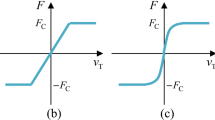Abstract
This study proposes a new frictional algorithm that implements angular increment. The proposed algorithm is used to solve the numerical solutions of dynamic problems in two-dimensional frictional systems. It can accurately obtain the motion responses of a lumped mass under time-varying external forces, and it can compensate for the shortcomings of the numerical frictional algorithm that implements a time step. Specifically, the proposed algorithm 1) overcomes the difficulties encountered when the angles between resultant tangential forces and slip motion are infinitely close, 2) provides accurate solutions for two-dimensional systems under fierce planar motions, and 3) calculates the responses of the mass within a reasonable period. We compare the computation accuracy, efficiency, and robustness of the proposed frictional algorithm and the previous frictional algorithm [1] through several representative scenarios. We reveal that the proposed algorithm has superior computation accuracy, efficiency, and robustness for two-dimensional frictional problems involving slip/stick transitions and sharp bending.
Similar content being viewed by others
References
X. Wang and J. R. Barber, Numerical frictional algorithm with implementation of closed form analytical solutions, Computer Methods in Applied Mechanics and Engineering, 300(1) (2016) 643–656.
G. Kudra and J. Awrejcewicz, Bifurcational dynamics of two-dimensional stick-slip system, Differential Equations and Dynamical Systems, 20 (3) (2012) 301–322.
M. Bazrafshan, M. B. de Rooij and D. J. Schipper, On the role of adhesion and roughness in stick-slip transition at the contact of two bodies: A numerical study, Tribology International, 121 (2018) 381–388.
R. Lima and R. Sampaio, Stick-mode duration of a dry-friction oscillator with an uncertain model, Journal of Sound and Vibration, 353 (2015) 259–271.
J. Scheibert and D. K. Dysthe, Role of friction-induced torque in stick-slip motion, EPL (Europhysics Letters), 92 (5) (2010) 620–622.
K. Nakano and Y. Kikuchi, Conditional expression for the oc-currence of stick-slip motion based on the coulomb friction model (Part 1): Formulation and approximation of con-di-tional expression, Japanese Journal of Tribology, 51 (1) (2006) 39–54.
I. Kardan et al., Stick-slip conditions in the general motion of a planar rigid body, Journal of Mechanical Science and Technology, 27 (9) (2013) 2577–2583.
J. R. Barber and X. Wang, Numerical algorithms for two-dimensional dynamic frictional problems, Tribology International, 80 (2014) 141–146.
T. Prior and E. J. Mele, A block slipping on a sphere with friction: Exact and perturbative solutions, American Journal of Physics, 75 (5) (2007) 423–426.
G. Kudra et al., Shaping the trajectory of the billiard ball with approximations of the resultant contact forces, Mechatronics, 37 (2016) 54–62.
M. Fadaee and S. D. Yu, Two-dimensional stick-slip motion of Coulomb friction oscillators, Proceedings of the Institution of Mechanical Engineers, Part C: Journal of Mechanical Engineering Science, 230 (14) (2016) 2438–2448.
F. Xia, Modelling of a two-dimensional Coulomb friction oscillator, Journal of Sound and Vibration, 265 (5) (2003) 1063–1074.
X. Wang, Trajectory of a projectile on a frictional inclined plane, American Journal of Physics, 82 (8) (2014) 764–768.
Acknowledgments
This project is supported by National Natural Science Foundation of China (Grant Nos. 51575403, 51705372).
Author information
Authors and Affiliations
Corresponding author
Additional information
Recommended by Associate Editor Hyeong-Joon Ahn
Deng Zhao is currently completing his Ph.D. at the School of Power and Mechanical Engineering, Wuhan University, Wuhan, China. Zhao’s main research topics are structural dynamics, contact mechanics, and computational fluid engineering.
Xiaosun Wang received his Ph.D. degree in mechanical engineering from Wuhan University in 2006. Dr. Wang is currently a Professor at the School of Power and Mechanical Engineering, Wuhan University, China.
Shijing Wu received his Ph.D. degree in mechanical engineering from Wuhan University in 2000. Dr. Wu is currently a Professor at the School of Power and Mechanical Engineering, Wuhan University, China.
Rights and permissions
About this article
Cite this article
Zhao, D., Wu, S., Li, Q. et al. Novel frictional algorithm implementing angular increment for two-dimensional frictional systems. J Mech Sci Technol 33, 3085–3094 (2019). https://doi.org/10.1007/s12206-019-0603-8
Received:
Revised:
Accepted:
Published:
Issue Date:
DOI: https://doi.org/10.1007/s12206-019-0603-8




